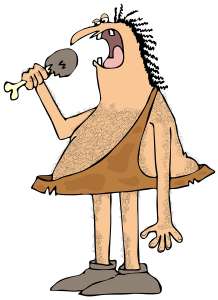
The idea of a paleo diet is compelling and simple. Loren Cordain, founder of the paleo diet movement, has put forward an argument to eat more like hunter-gatherers did 15,000 years ago — before as a species we became societies of farmers. The theory claims that we have not had enough time to genetically adapt to our relatively “new” agricultural-based diets, and especially not to the processed food diets of the current industrialized era. Following this fundamental principle guides us to eat like hunter gatherers did. This means no processed meat and plants, no additives like salt or sugar, and eliminating all agricultural crops. This means no corn, rice, wheat, soy, potatoes, or legumes (to name a few), and no refined vegetable oils. On the paleo diet you can eat eggs and meat, preferably from animals fed their original “wild” diets and not on agricultural crops like soy and corn.

Gord Grant PhD, RAc
Also, dairy is not allowed since this food was adopted into our diets only recently, since the time when farm animals were domesticated.
Cordain makes bold claims: not only will the diet help you lose weight, increase overall energy, vitality and libido, and but it will also reduce the incidence of many chronic diseases and increase your lifespan.
One problem with the theory is there was not “a” hunter-gatherers’ diet. They did indeed live a life of moving with and adapting to the food supply, with the nature of their food widely varying based on the particular climate and food available. From these differences we know there were and still are very significant genetic differences among humans regarding metabolism and digestion. For example, generally speaking, Asians and natives of the Americas including northern Inuit, who are more closely related, tend not to have the same capacity to digest lactose in milk or metabolize alcohol fermented from grain crops as do more recent descendents of Europe. Variations in our metabolism and digestion need to be addressed non-prescriptively by each person in this global world.
I get it that we are not eating well in the modern era of processed foods and we would benefit from more whole foods, more vegetables and less sugary things….but should we throw out the whole foods developed since the agricultural revolution over the last 10,000 years!? Regardless of whether you agree or not with the fundamental principle of the paleo diet – that we should eat like our earliest ancestors did — the diet does help us shift us toward what most scientifically-trained nutritionists are already telling us to eat. They say we should eat less refined carbohydrates and more lower-fat protein, more nutritious fat sources (higher in omega-3 fatty acids), more fibre (soluble and insoluble), less sodium (table salt), and more whole non-starchy fruit and vegetables from a variety of sources. However, the paleo diet restrictions against dairy, wheat and potatoes and other agriculturally domesticated crops may not make so much sense if you obey some basic scientific principles and knowledge.
I believe it is possible to have a thoughtful and flexible approach in pursuing a healthy diet, beyond a simplified anti-agricultural premise. I believe it is important to eat a variety of whole foods in a reasonable way, explore the recipes of traditional diets, understand the basic scientific principles of food and nutrition, and most importantly, observe how you feel when and after you eat something. I believe this approach would serve as a more reasonable and resilient foundation from which to optimize one’s diet.
But let’s take some of the details of the paelo movement claim each in turn, and analyze the underlying scientific principles that we could better apply thoughtfully, instead of following more rigidly applied paleo diet rules.
Paleo benefit 1: Regulating blood sugarWe know we need to lower the amounts of carbohydrates and sugars we are eating in our agricultural based grain diets. How much though? Any one component in our diet cannot be considered alone. How the body processes protein in the absence of carbohydrates makes a difference. We know that fibre in whole foods affects the rate of digestion of starch, and alters the rate of release of blood sugar (lowering glycemic index). Type II diabetes seems to be an affliction of confused messages to the body.
So here’s the story: In hunter gatherer times, when the body saw glucose rise in the blood, it had evolved to know this meant there was a significant amount of glucose yet to be released from starch (plant source of sugar) or glycogen (meat source of sugar). Insulin was released from the pancreas to store the sugar away into the cells of the body for future use, and the load of digested carbohydrates was aptly processed in time over the next hours. Fast forward to the present day, and the body sees a quick hit of glucose coming in to the blood supply (pop, candy, chocolates, or whatever your favourite sweet fix is), and it sounds the alarm bells that a really big starch meal has been eaten! INSULIN release, INSULIN release!!! Quickly the glucose in the blood gets squirreled away waiting for the onslaught of more sugar…but none comes, and the body can’t take back the extra insulin, and the blood sugar drops to lower than is good for you! You feel tired, and lethargic, and seek another sugar fix. In the meantime, the body has reversed gears, and the pancreas releases the opposite acting hormone, glucagon, which drives out sugar from the liver to supply the glucose starving tissues needed glucose. This partially helps, but by now, you have already got your next sugary drink! The roller coaster ride continues. This also applies more or less to refined carbohydrates (white flour bread) or highly digestible starch sources eaten alone (potato chips), where huge surges of glucose are released to the bloodstream in a way that hunter gatherers likely seldom experienced when they had a varied diet.
But this doesn’t mean we have to avoid agricultural crops. Agricultural sources of starch (grains and potatoes, etc), if eaten in moderation, as whole unrefined foods, in combination with other foods with protein and fibre bulk, will naturally limit the release of glucose to the blood stream.
The anti-wheat trend has been radical, but the evidence so far shows that for most of us, wheat is not a problem if eaten in moderation (see my blog on this: Are we what we Wheat?). In other words, it comes back to eating less starch and more whole unrefined fibre-filled sources of carbohydrates in proper combinations and proportions with other food components. Most of us do not have celiac disease, nor a gluten or wheat sensitivity, but most of us ARE eating too much refined carbohydrates and not enough fibre and vegetables. I believe that for most people, if the wheat-free diet works, it is not because it is eliminating wheat from the diet per se, rather it is because it represents a lower carbohydrate and higher fibre diet in a culture dominated with refined wheat flour processed foods!
Paleo benefit 2: Higher protein It is not difficult to get our daily protein needs, especially if we eat meat. The paleo diet recommends getting 19-45% of our calories from protein, whereas nutritional wisdom in most scientific circles suggests that depending on our age, up to but not more than 35% of calories should come from protein. High protein low carbohydrate diets, like the Atkins diet, have been shown to be effective in losing weight, but they may be metabolically stressful on our bodies, since the nitrogen and sulphur in protein need to be processed for excretion, both of which challenge our liver and kidneys. In fact, high protein and low B vitamin diets contribute to western cardiovascular disease through reactive metabolic intermediates like homocysteine, causing oxidative damage to blood vessels. A high protein paleo diet does not suffer from this issue, since vegetables are a great source of B vitamins. But the classic western diet of meat and carbs with little vegetables may be a red flag here!
It is important to remember that not all protein is created equal. Ideal protein is made up of the correct proportion of essential amino acids that we cannot manufacture ourselves. Animal protein has the same essential amino acid profile as the protein that we need and are made of – simple. But plant protein does not, and traditional diets usually evolved a combination of legumes and grains which complemented one another to achieve perfect or near perfect ratios. But we became vulnerable to primary protein nutritional problems when we did this, whereas hunter gatherers foraged and hunted for a wide variety of foods changing throughout the seasons and years, such as insects, frogs, tubers and grains. Yes, grains. There is evidence that prehistoric humans would migrate and set up camp to forage the precursors of our grass grains like wheat and rice and potatoes long before they were domesticated. So protein and starch and fibre from whole grain sources are likely a great contribution to our diet, even from a paleo principled perspective!
As discussed with respect to the anti-wheat movement in part 1 of this blog, eliminating wheat may not be based on good reasoning from a scientific standpoint nor apply to any one person particularly. The same applies with the anti-dairy movement. Agricultural grains and legumes, and milk products may be great sources of protein and other nutrients to add to your diet. Don’t dismiss them just because our ancestors didn’t them 10,000 years ago.
Paleo benefit 3: Moderate fat intake with more Omega-3s
The advent of large quantities of purified oils in our processed foods has created a distortion of the “natural” ratio of omega-3 to -6 fatty acids with which we have evolved. We now understand how the ratio of omega-3 to -6 has been turned upside down in modern diets and may be at the root of a lot of disease through creating unnecessary inflammation in our bodies, especially cardiovascular disease. Ruminant animals like deer, sheep and cattle that just eat grass (like they used to before agriculture) have an increased proportion of omega-3 fatty acids in their meat. And behold, meat from these animals becomes higher in omega-6 when they are finished on agricultural grains (and so do we when we eat them!). Some people supplement with omega-3 tablets, or eat oily fish or flax or hemp seeds high in omega-3 to balance out the ratio of omega-3 to -6. But when you look at paleo diets, there was a huge variance in omega-3 to -6 ratios. Inuit diets had double the omega-3 to -6, whereas other hunter gathers had ratios closer to unity or slightly higher in omega-6, but all with far greater proportion than our current society’s ten to thirty fold greater proportion of omega-6!!! So until the research is out, I would say it is safe to increase your omega-3 consumption in whatever sustainable way you can. Many scientists and governments say that a diet with a 1:4 ratio of omega-3 to -6 is healthy. But based on your particular genetics and lifestyle, you should pay attention to how you feel as you eat various proportions of omega-3 rich foods.
Paleo benefit 4: More fibre: This is one of the most interesting and complex areas of research. Fibre isn’t just fibre. Fibre is not nutritionally essential, however it has very large impacts on our health and vitality and metabolism. The bulk cellulose type fibre we associate with celery and bran, serves as a bulking agent that holds water and allows the digested contents to be propelled properly and easily down the digestive tract and through the colon. The nature of stools has a lot to do with this one. This fibre influences the glycemic index of the food we eat by interfering with enzyme access to starch molecules. The other type of fibre is generally classified a soluble fibre, and like the name implies, can dissolve in water. It is a fibre because we do not have the digestive enzymes to break it down. This fibre comes in different forms, such as beta-glucan (from unrefined oats and barley) or inulin (from strawberries or artichokes), and not only can interfere with starch digestion to slow down glucose release, but also feed our colonic bacteria. The bacteria do have the enzymes to break this fibre down to glucose, and indeed they create gas and lower the colonic pH. The health benefits go far beyond colon health, and we realize now that a healthy bacterial population depends on this fiber, and immune systems and metabolisms also thrive if these bacteria are well fed. Shifting to whole foods, both grains and non-starchy fruits and vegetables makes it much easier for us to get our 30g a day of soluble fibre….we likely could use more than this, and no optimal level has yet been determined. Why not experiment?
Paleo benefit 5: Less sodium, more potassium. Humans, unlike many of the animals we hunted, could run huge distances in the heat, since we could sweat and cool ourselves. Sodium is critically lost in sweat, and we craved it and sought it out at salt licks. In early societies salt was once a precious currency, since it was used to preserve foods, another agricultural dilemma where we could settle down and give ourselves extra calories by guaranteeing food for tomorrow. But now, our craving is an affliction of cultural conditioning and not food preservations; processed foods and the salt shaker on the table make it a dangerous addiction! Just eating whole unprocessed foods without adding salt is enough to shift the balance — we don’t have to eliminate agricultural products from our diet.
Paleo benefit 6: Greater intake of vitamins, minerals, and phytonutrientsWe know that we get so much more from whole foods: not only the vitamins and minerals but a whole host of non-essential nutrients and components that help our health. Of course we can take pills if we don’t get adequate vitamins or omega-3 or sunshine in our lives. We know a lot about primary nutritional deficiencies as discovered over the last century. But we know much less about optimal vitamin and phytonutrient intake, for health beyond longevity and avoiding disease. So it is very complex and not the stuff of most scientific research due to the subtle complexity and individual variations. We know that beyond the crude value of vitamins, plants also hold slightly toxic anti-nutrients, often bitter, that promote health through challenging and bolstering liver function. Furthermore, excess supplementation or even constant “optimal” supplementation may not be healthy for us in a non-varied regime intended to be at our best. There is evidence that not shaking things up and switching food sources (and vitamin levels) may make our body’s metabolism go on a virtual holiday. If we are awash in excess micronutrients we don’t have to develop a fitness to absorb and/or conserve. For instance, one study showed that baby guinea pigs weaned from a mother who was hyper-supplemented with vitamin C, showed all the symptoms of vitamin C deficiencies when they ate a normal diet on which other baby guinea pigs from mothers on normal chow thrived. Supplement sometimes, but be careful, since you may need to adapt to changing conditions in your health and diet and require the ability of your body to do so!
More paleo ideas: And here are a couple more ideas in 6 and 7, not included in the paleo diet movement, but I feel are sensible and worth trying out.
7. Paleo Fasting:The evidence of fasting has recently been made popular by Micheal Mosley in his book “The Fast Diet”. This is not about putting the body into starvation mode. The idea of intermittent fasting derives from paleo logic in that regularly we would have needed the capacity to travel light while hunting, foraging, or travelling to a new land. Metabolically we evolved and adapted to endure, and arguably thrive, on these types of challenges. From a metabolism point of view, there is good science behind why we should gently and periodically restrict calories on a regular basis. This seems to put the body into a healthy metabolic position. Reducing calories one day per week (or two, not consecutively) down to 30-40% of normal can put the body’s metabolism into a favourable status demonstrated by blood parameters that predict decreasing the risk of chronic disease. Of course too much stress from fasting increases disease and is not good! The trick is to be observant enough to know if it is helping you or not based on your particular situation!
8. Paleo food craving and avoidance: flavour and learning what is good for you by experience: One more paleo comment, which has to do with our paleo past, but not included in Cordain’s paleo movement. Mark Schatzker’s provocative book, “The Dorito Effect: the surprising and new truth about food and flavor”, documents the research and idea of nutritional intelligence. Again, for hunter gatherers, our survival was critically dependent on our ability to taste the nutritional potential of food. We both had to teach it to our children, but we needed to adapt faster than our genes as we occupied the globe and adapted our diets in a relatively short time. So we have taste for a reason, and it unlikely to primarily to enjoy food for that sake alone! The nature of desiring sweet, salty, savoury likely predicted the quality of food we are about to eat.
Carbohydrates provide us with critical energy for our body’s fundamental glucose economy (almost all energy is interconverted between glucose or fat in our body). We can taste the subtle sweetness in food with a high carbohydrate content because with have amylase enzymes in our saliva to break starch down into sugars. These salivary enzymes are not there to digest our food, but to sample and assess their calorie content! The savouriness or the “umami taste” of food is also desired and predicts nutritional content again. It can be perceived not only by fat content, especially flavourful omega-3 fats which also go rancid quickly (not as much a problem to hunter gatherers perhaps?). Specific amino acids like glutamate (msg=a salt of this amino acid!), and other small protein and amino acid flavours contribute to umami that predict essential nutrients. Schatzker argues that we have become addicted to the unlimited supply of sweet and savoury and salty, but dangerously unconnected to nutrition it once predicted, since we purify and consume these components in isolation. Going one step further, Schatzker provides evidence that most animals need and can make dietary decisions. Grazers and omnivores, and hunter-gatherers like us, have developed a keen sense of nutritional wisdom. When we eat something that makes us feel good in the hours to day after, we seek it more. When we eat something that makes us feel bad later, we avoid this and remember it. This is a critical trait to not only adjust to changing seasonal landscapes and new foods as we explored new lands, but also to adjust to our own particular complex mix of situations in optimizing our health. He offers a simple solution of eating whole foods, foods grown slowly with potent flavour (not necessarily “organic”), and enjoying the flavours and paying attention to how it makes you feel in the moment, and as you get full, and later over the next hours and days.
Our hunter gatherer bodies evolved to be very, very conservative, and adapted to many variations in our environment as we populated the globe. Like other animals, we did not put energy and resources into a bodily capacity unless the environmental stressors challenged us to do so. Today, the rules are not different. If we don’t give moderate and non-injurious stress to muscles to work and coordinate, they atrophy and we lose capacity to move. The same is true of our cardiovascular system, our immune, digestive, metabolic, and temperature regulation systems, and so to our cognition systems of memory, spatial orientation, logic, creativity, physical awareness, and on so on.
I do believe that feedback that was necessary for the paleo life we once lived, and the life our genes still do reflect closely, can inform us in way that a doctor and clinical blood measurements cannot. This is why at our clinic we usually assign tracking homework where we encourage our clients to monitor their diets, their activities, and other factors fluctuating in their lives such as sleep, energy, etc. Acupuncture and our other modalities catalyze change in normalizing stress and strain for a few days, and then the opportunity for the client to discover and make the necessary changes is made easier, and a positive cycle of change is made.
So the next time you are struggling with your exercise, or diet, or work, remember, so too have your ancestors for millennia. Remember then, perhaps more than any other animal species on earth, you are wonderfully made for adaptation to your environment, both in mind and body.




